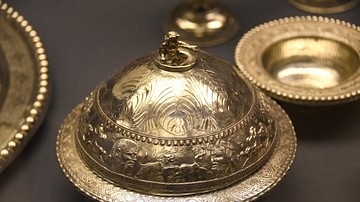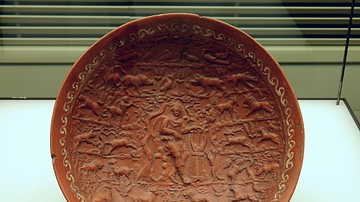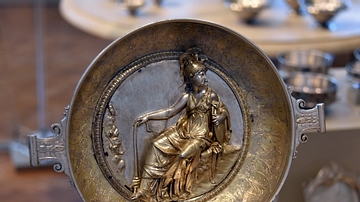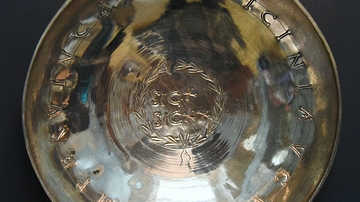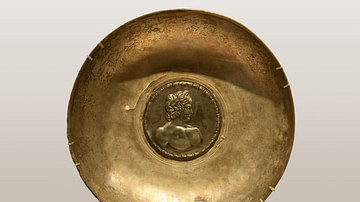Illustration
The most famous object in the Mildenhall treasure is the large, highly decorated circular platter, usually known as the Great Dish, or as the Neptune or Oceanus Dish. Bacchic imagery has a long history in Greek and Roman art, and this example, on a magnificent silver vessel measuring 60.5 centimetres in diameter and weighing 8,256 g, is one of the finest to survive from the late Roman period. The decoration, worked in low relief and engraved lines on the front surface of the silver, alludes to the worship and mythology of Bacchus, on land and in the sea. The staring face in the centre is Oceanus, his beard formed of seaweeds fronds and with dolphins in is hair. The inner circle, bordered by scallop shells, consists of sea nymphs riding mythological marine creatures, a seahorse, a trion, a sea-stag, and a ketos, a dragon-like sea monster. The wider outer frieze features Bacchus himself, holding a bunch of grapes and a thyrsus (a staff-tipped with a pine-cone) and resting a foot on his panther, presiding over a celebration of music, dancing and drinking in his honor. The participants include the hero Hercules, overcome by wine, the goat-legged god Pan, and sundry satyrs and Maenads (female devotees). From West Row, Mildenhall, Suffolk, UK. 4th century CE. (The British Museum, London)
About the Author
Cite This Work
APA Style
Amin, O. S. M. (2016, April 20). The Mildenhall Great Dish. World History Encyclopedia. Retrieved from https://www.worldhistory.org/image/4973/the-mildenhall-great-dish/
Chicago Style
Amin, Osama Shukir Muhammed. "The Mildenhall Great Dish." World History Encyclopedia. Last modified April 20, 2016. https://www.worldhistory.org/image/4973/the-mildenhall-great-dish/.
MLA Style
Amin, Osama Shukir Muhammed. "The Mildenhall Great Dish." World History Encyclopedia. World History Encyclopedia, 20 Apr 2016. Web. 13 Apr 2025.



